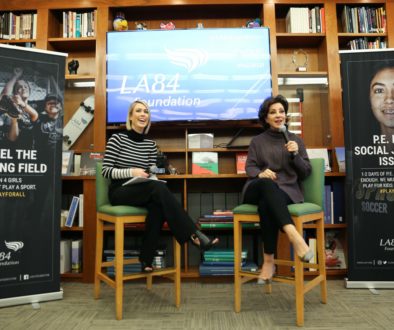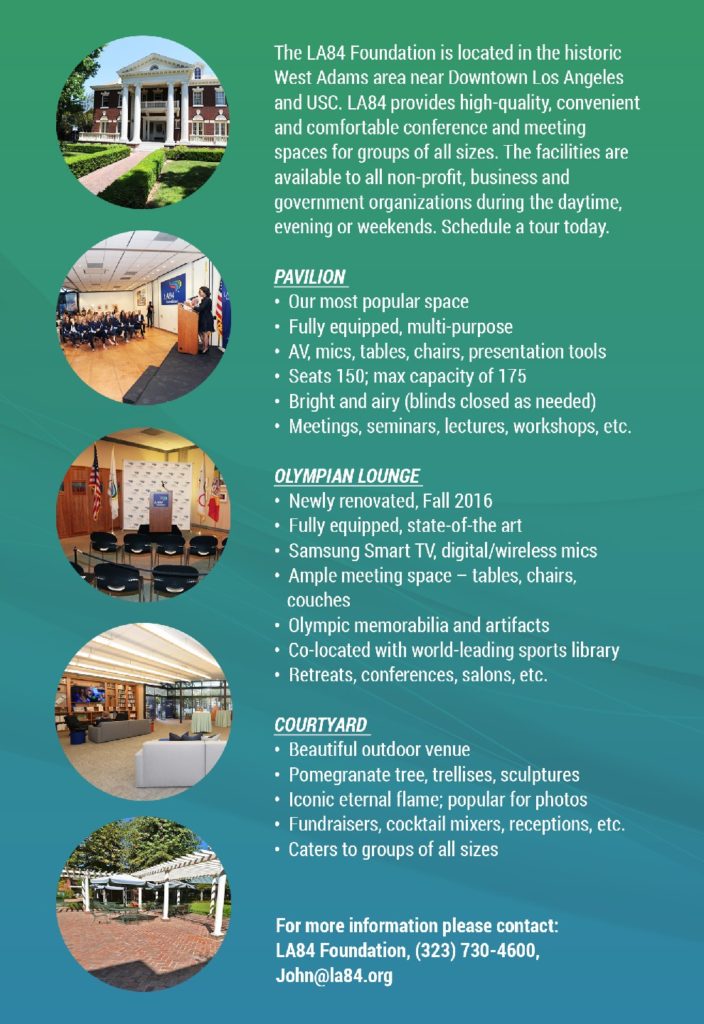SL Interview: Terri Lakowski on Access to Sports for Kids with Disabilities
 Earlier this year, U.S. Secretary of Education Arne Duncan issued a “Dear Colleague” letter through the Office of Civil Rights. The letter clarified the responsibility of schools for providing extracurricular athletic programs for students with disabilities, as outlined under Section 504 of the Rehabilitation Act of 1973.
Earlier this year, U.S. Secretary of Education Arne Duncan issued a “Dear Colleague” letter through the Office of Civil Rights. The letter clarified the responsibility of schools for providing extracurricular athletic programs for students with disabilities, as outlined under Section 504 of the Rehabilitation Act of 1973.
The message of Secretary Duncan’s letter was simple and direct: Schools must give students with disabilities access to sports programming that is “equal to that of students without disabilities.”
The letter also offered a road map for school administrators and athletic directors concerning when and how to integrate students with disabilities into mainstream programs and when and how schools should create adapted programs for students with disabilities.
Many commentators have characterized the release of the “Dear Colleague” letter as the “Title IX moment” for students with disabilities, referring to the fact that, some 40 years after the passage of the Education Amendments of 1972, Title IX has helped increase the participation and opportunities for women and girls in sports and changed the perception of female athletes.
While it is too early to measure the long-term impact of the “Dear Colleague” letter, its message represents a sea change in attitude, according to Washington, D.C.-based attorney Terri Lakowski. As CEO of Active Policy Solutions, which works with groups on myriad sports policy issues, including youth sports, Lakowski helped forge the campaign that led to the “Dear Colleague” letter. She is also policy chair of the Inclusive Fitness Coalition, which works to “expand opportunities for physical activity, exercise and athletics for individuals with disabilities.” And she is on the Board of the American Association of Adapted Sports Programs, which “works in partnership with educational agencies in the U.S. to establish programs, policies and regulations in interscholastic adapted sports for students with physical disabilities to enhance educational outcomes.”
SportsLetter recently spoke to Lakowski about the “Dear Colleague” letter and the movement to provide comprehensive opportunities for youth athletes with disabilities.
–David Davis
SportsLetter: How did you get involved in working for disabled athletes?
Terri Lakowski: My background was as a Title IX advocate, working with the Women’s Sports Foundation for six years as their public policy director. In that context, we were approached in 2006 by the Maryland Disability Law Center, which was litigating a case at that time involving a high school student-athlete with a disability. Through my exposure working on this case, I began to see parallels between the history and advocacy movement for women and girls in sports and the need for a more rigorous national movement to advance the cause of athletes with disabilities.
As an aside, at that same time I went down to Georgia and had the opportunity to play wheelchair basketball with a group of kids who were participating in an AAASP [American Association of Adapted Sports Programs] game. After sitting in a wheelchair and playing basketball with them for an hour, I was totally hooked.
SL: What happened with the case in Maryland?
TL: We were brought in as consultants on a case involving Tatyana McFadden. [Editor’s Note: Born with spina bifida, McFadden sued the Howard County school system in Maryland for the right to compete alongside able-bodied competitors; most recently, McFadden won three gold medals at the 2012 Paralympic Games.] It was really this light-bulb moment for myself and for Donna Lopiano [then-executive director of the Women’s Sports Foundation]. We saw that there needed to be further guidance under the Rehabilitation Act [of 1973] to clarify what it meant for schools to provide equal opportunities for students with disabilities.
What we saw in the McFadden case was that, despite the fact that the court agreed with our desire to have the athletes with disabilities treated equally, the law just wasn’t behind us. So, at that time, I led an effort in Maryland in partnership with Special Olympics Maryland and the Parent Teacher Association of the Maryland Disability Law Center to pass legislation in the state to close that gap. That became the Fitness and Athletic Equity Act for Students with Disabilities in Maryland.
SL: When did this effort move from the local level, with the case involving Maryland, to the national level?
TL: After the state law was passed in Maryland in 2008, we found champions in Sen. Tom Harkin (D-IA) and Reps. George Miller (D-CA), Chris Van Hollen (D-MD) and Carolyn McCarthy (D-NY) to commission a Government Accountability Office study to look at the opportunities for students with disabilities. The GAO study showed what we’ve been saying for years: there is a significant lack of infrastructure for students with disabilities, and there is widespread confusion at the school level about how to accommodate students, including what the schools’ legal obligations are to accommodate them.
One of the recommendations that came out of that study was that the Department of Education should issue further guidance on the Rehab Act to clarify what schools’ obligations are. Following that recommendation, Secretary of Education [Arne] Duncan committed to doing just that, with the issuance of the “Dear Colleague” letter earlier this year. So, the “Dear Colleague” letter was the culmination of a very deliberate advocacy effort over nearly ten years.
SL: What does the “Dear Colleague” letter clarify about the requirements of the Rehab Act?
TL: There are three areas in the “Dear Colleague” letter. The first one deals with the issue of mainstream programming. This is, in fact, not a new requirement. It’s been on the books for years. It’s just that schools haven’t been compliant with it thus far. What the “Dear Colleague” letter clarifies is that schools have an obligation, and have had an obligation, to provide students with disabilities reasonable accommodation to the maximum extent possible in mainstream programming.
The letter gives specific examples of what reasonable accommodation looks like. For example, if you have an amputee who wants to swim, modifying a two-hand touch rule in a swim meet would allow this person to compete. Or, if you have a deaf athlete, adding a lighting devise in addition to a sounding gun at a track meet would allow him or her to participate.
It also takes schools through two circumstances under which they would not have to provide accommodation — in other words, where the accommodation would become unreasonable. Those instances are, essentially, where they cause the game to change significantly. For example, if you’re putting a wheelchair on a basketball court, that’s going to fundamentally alter how the kids play basketball. So, that’s not a reasonable accommodation.
The other instance where it would not be reasonable is, if the accommodation gives the athlete with a disability an unfair competitive advantage. In the instance of an amputee swimmer, if they were competing in the Olympic Trials, where milliseconds separate the winners and the losers, modifying the two-hand touch rule could be construed as giving the person an unfair advantage. At the high school level – probably not so much.
Allowing an athlete in a wheelchair to race against a footed athlete would give them an advantage. But allowing wheelchair athletes to have their own division at the state track and field meet, where they would race against other wheelchair athletes, is not an advantage.
SL: What are among the challenges that schools face with compliance?
TL: Most school systems do not have a policy for how to individually assess students with disabilities who want to play on their sports teams. They need to do that. The schools need to be proactive. That’s the first basic step: creating a policy and a system where they can evaluate, on a case-by-case basis, these accommodation requests.
The second part of this is looking at developing adapted programs, or unified programs, for kids with intellectual disabilities. The guidance letter also covers this. It encourages schools to create adapted programs wherever they can. In this instance, schools need to work in partnership with the leadership within their state high school athletic associations and the state athletic director associations. They have to be strategic about how they add opportunities for students with disabilities because they just don’t have the same numbers.
Looking at what they’ve done in Georgia, both in rural Georgia and in Atlanta, it’s certainly workable anywhere in the country. What they’ve done in Georgia is, find a critical mass and pick a sport that allows for one adapted sports team per season. They have cooperative teams, where they will have one team per school district, where they’re including kids from seventh grade all the way up to high school, with boys and girls participating on the same team. And, they use those sports where, whether or not the student-athletes use a wheelchair for their daily mobility, they can all participate in a chair. So, while someone might be an amputee who can walk, they’ll play basketball in a wheelchair, which enables there to be enough numbers to field a team.
That’s precisely what the guidance is talking about. It’s not saying, go add every Paralympic sport at every school. That’s not workable. But, can you get together with your partners and the school districts across the state to create an adapted opportunity every season for these kids? That’s certainly feasible, although it will take creative thinking and planning.
SL: Why did it take so long for the clarification to come, with the Rehab Act being passed in 1973?
TL: I can’t tell you why it wasn’t done before. I think it was a missed opportunity for years. It’s interesting to note that, where Title IX has been so successful for women and girls, it was not with the passage of the original statute in 1972. It was with the regulations and the guidance that came about later, in 1975 and 1979, which delineated what schools’ responsibilities were to provide girls with meaningful opportunities.
SL: What recreation options are available now for disabled youth athletes at your typical elementary school or high school?
TL: There are very few opportunities. That’s essentially what the GAO study commissioned in 2008 and released in 2010 found. There is a significant lack of infrastructure to provide students with disabilities the opportunity to participate in the mainstream environment, which is where they’re playing with kids without disabilities. More often than not in this environment, those students are only included because they demanded it or they fought for it. The system was not and has not been proactive thus far.
In the adapted environment, which are programs specifically designed for students with disabilities, it is virtually nonexistent. At the high school level, less than ten states across the country have some sort of adapted programming for students with disabilities. Where those do exist, you’re usually talking about one sport in one season. So, maybe they have an adapted wheelchair division in the track and field program. But it’s very rare.
SL: Which state offers the best recreation options for youth with disabilities?
TL: Georgia is one the leading states in this. They have the advantage of having a nonprofit group based there in Atlanta, the American Association of Adapted Sports Programs [AAASP]. They’re a legacy organization of the 1996 Atlanta Olympic Games. They started to provide programming for students with disabilities in the school system, in partnership with the Georgia high school athletic association. They’ve been very successful and have set a standard and a model for the nation on how students with disabilities can be successfully integrated into a high school athletic program.
SL: What is the best option for kids: to have mainstream programs – where those with disabilities compete alongside their peers — or to have adapted athletic programs, like wheelchair basketball?
TL: The best case is that they have both. Students with disabilities should have the opportunity, if they can, to participate in a mainstream program. Depending on the nature of the disability, they might not be able to do that. Certain sports are not conducive to being integrated, so they would need an adapted program to be created. The bottom line is, we need to create a system to support all students with disabilities and allow them to have choices for participation in athletics.
SL: What about students with intellectual disabilities: what are their options?
TL: The Special Olympics people have created the model for developing programs for students with intellectual disabilities through their unified sports programs. These are currently running in many school systems throughout the country. In most instances, the students with intellectual disabilities are integrated as part of the varsity sports team offerings: they play on competitive teams paired with a student without an intellectual disability. It’s a great way for them to have the opportunity to participate in more mainstream programs, and I think schools will use this format to serve kids who do have a primary disability that is intellectual.
SL: What do parents who have a child with a disability need to know about this issue, and what do coaches need to know about this?
TL: Parents need to know that their kid has the right to participate in athletics at their school. They need to be proactive and ask questions of their school systems. For instance, does the school have a policy for disabled student-athletes in place? What is the process for evaluating my child and including them in a sports program? If the school doesn’t have these in place, they need to work with their school to create a plan and implement it.
Coaches need to be educated on the appropriate ways to accommodate the kids into their programs. There’s a lot of education and outreach that needs to be done. The important thing for them to remember is that there are a lot of groups who are doing this well in the community already, from Special Olympics to Paralympics to AAASP. They are qualified to support the coaches and the parents in developing these programs in the school systems. The coaches should reach out to those experts to facilitate the best practices.
SL: When you started this effort, did you find that people assumed that youth with disabilities did not want to participate in sports?
TL: Absolutely. And, that goes back to the parallels we saw with Title IX and women and girls in sport. You often heard the argument back then that girls aren’t interested in playing sports, that they don’t have the same ability and the same desire to play sports as boys. We’ve seen, since the explosive growth of women’s sports since Title IX, that that is simply not the case. The exact same thing is true for people with disabilities. They’re often viewed as not capable or not interested in playing sports, when in fact as an opportunity develops for them, they come out in droves for it.
SL: How important is it for youth with disabilities to be physically active and have the opportunity to participate in athletic programs?
TL: You look at the benefits that sports has for any kid, and they’re astronomical. They’re less likely to drop out of school, they have higher self-esteem, they show better student leadership skills, they have healthier lifestyles and lower childhood obesity, they’re less likely to have teen pregnancy, they have lower rates of smoking. All of these same youth development components are there for kids with disabilities and then some. For some students with disabilities, the ability to be proactive and have the physical experience that comes with sports is literally the difference between them thinking they can be self-sufficient throughout their entire lives and them not thinking that. And so, the stakes are significantly higher when we’re talking about the value that sports can bring to kids with disabilities – as they are equally valuable for other kids as well.
SL: What has been the biggest challenge for advocates like yourself on this topic?
TL: The attitudinal barriers that continue to be pervasive for students with disabilities, in seeing them as capable of participating in sports or qualified to participating in sports, is huge. And, not creating this us-versus-them scenario that we still hear time and time again: How can you provide opportunities for students with disabilities without taking away opportunities for students without disabilities?
From our framework, there are creative solutions to do this without creating a huge financial burden. We should be focusing on those solutions as opposed to just going into sticker-shock thinking, “Oh my gosh, we have to create ten new wheelchair athlete programs for our school.” That’s not what this is saying.
When schools and administrators hear that there is a need to expand programs to accommodate a new population group, they automatically think worst-case scenario for their budgets. Not to ignore that: budget and finances are going to come into play here. But this is a long-term process that requires creative planning and systemic solutions. I do believe that our school administrators and our athletic directors see the value and want to integrate students with disabilities into their programs. The challenge is figuring out the best way to do so.
SL: How important are events like the Paralympics and the Special Olympics to this effort?
TL: They’re great resources for how to do this well. When we’re dealing with the issue of how to make modifications and adaptations in mainstream sports programming, that’s what those organizations do every day. They have graded classification systems, and they know how to work with this population group and get them into both mainstream programs and adapted programs. They’re incredibly important as a model.
The Paralympics also have the top of the mountain – the elite athletes – so that kids with disabilities coming up in our youth pipeline have role models who are Paralympians.
You can’t undervalue the important role that that has in shaping these kids’ lives and their ability to aspire to become the next Tatyana McFadden and winning gold medals in the Paralympic Games.
The Special Olympics similarly have an amazing institutional history and knowledge of how to serve students with non-physical disabilities effectively. Now that they’re growing into school systems with their unified program, I think that they’re going to be an incredibly important partner for our schools and a resource for figuring out how to do this.
SL: What are the pros and cons of athletes with disabilities competing alongside other athletes, as we saw at the London Olympics with Oscar Pistorius?
TL: I think we see that, in all walks of life, diversity and inclusion is always a value-added component. We only see value being added in integrating students with disabilities into our athletic environment. There are going to be challenges and things to figure out in how to do that most effectively and ensuring that we’re not hiding behind preconceived notions.
One issue that came up with Oscar Pistorius was the question: Do his artificial legs provide a competitive advantage? Research after research showed that, the pain and detriment of literally having your bone hitting the spring of the prosthesis far outweighed any advantage or potential advantage. There were those who came in saying, “He has these special legs. He’s going to be able to run faster.” No, the accommodation makes the playing field level. It gets him in the door. So, I think we have to be careful about having those stereotypes preclude us from being more inclusive.
SL: Many people have called the “Dear Colleague” the “Title IX moment” for athletes with disabilities. Do you agree with that assessment?
TL: I absolutely think that this will do for students with disabilities what Title IX has done for women and girls. I hope that we don’t have to wait 40 years before we see the change and progress for students with disabilities as we’re now seeing for women and girls.
If you look back to 40 years ago, the NCAA initially wasn’t supportive of Title IX at all. What’s unique about this is that the leadership of our athletic associations — the NCAA, the National Federation of State High School Associations, the National Interscholastic Athletic Administrators Association — have all been incredibly proactive and responsive to this guidance. We have the institutional leadership on our side to help us shepherd this change. I think that’s only going to make progress more expedient and effective.
SL: Why the change?
TL: It’s certainly a different time than 40 years ago. The people in positions of power today are real visionaries. They are student athlete-first people. They really are there for the kids. They get it. They get that sports is important for all kids, including kids with disabilities, and they want to make that work and are willing to think creatively about how to do so for any and all kids. That’s exactly what we want from our administrators, and I commend them for having that type of mentality.




